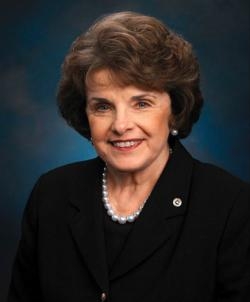Sat, Jun 20, 2015
Claims Dozens Of Near Misses Between UAVs, Passenger Airplanes Reported To FAA
Senator Dianne Feinstein (D-CA) has introduced the Consumer Drone Safety Act, which would protect the public and U.S. airspace by requiring safety features for consumer drones and strengthening the federal laws that govern their operation. Senator Charles E. Schumer (D-NY) cosponsored the bill.

Under current law, the FAA does not have the authority to require manufacturers of consumer drones to include technological safeguards. There are also no clear federal rules on when, where and under what conditions recreational users can operate drones.
In response to a letter from Senator Feinstein (pictured), the FAA released data on more than 190 incidents where pilots sighted drones over a nine-month period, including more than two dozen near mid-air collisions.
“If we don’t act now, it’s only a matter of time before we have a tragedy on our hands,” Senator Feinstein said. “Consumer drones are a new technology. They can fly thousands of feet in the air and jeopardize air travel, but the FAA can only regulate them if they are used for commercial purposes. That loophole must be closed.
“The reports of dangerous operations and near misses are only increasing. From incidents at LAX to La Guardia to the Golden Gate Bridge, the risk is clear. It is time to close the gaps in FAA’s authorities to protect the public safety and keep our skies safe.”
The Consumer Drone Safety Act would put in place common sense safety precautions to minimize the risk of a disastrous mid-air collision or crash to the ground.
The bill:
- Defines “consumer drones” as civil unmanned aircraft manufactured for commercial distribution and equipped with an automatic stabilization system or a camera for navigation. This definition does not override Section 336 of the FAA Modernization and Reform Act of 2012 and model aircraft flown for recreational purposes would continue to be subject to the safety guidelines of a community-based organization rather than to operational regulations of the FAA.
- Directs the FAA to regulate recreational operations of consumer drones outside the programming of a nationwide community-based organization.
- These regulations shall include a maximum height for flight, the weather and time-of-day conditions for flight, and any areas or circumstances where flights may be prohibited or limited, such as near airports, in the flight paths of manned aircraft, in urban areas, or over public events where spectators are present.
- Directs the FAA to require safety features for newly manufactured consumer drones, such as geo-fencing to govern the altitude and location of flights, collision-avoidance software, precautions for the loss of a communications link, a method for pilots and air traffic control to detect and identify the drone, anti-tampering safeguards, and educational materials to be provided to the consumer.
- Requires manufacturers to update existing consumer drones to meet these requirements where feasible, such as through an automatic software update.
- Allows the FAA to exempt particular types of consumer drones from any requirement that is technologically infeasible or cost prohibitive if other operational precautions allow that type of drone to be operated safely.
The bill is supported by the Airline Pilots Association, the Southwest Airlines Pilots Association, the American Association of Airport Executives, the National Association of Broadcasters, San Francisco International Airport, the Golden Gate Bridge Highway and Transportation District and Captain Sully Sullenberger.
(Image from file)
More News
Aero Linx: Commercial Aviation Safety Team (CAST) Founded in 1997, the Commercial Aviation Safety Team (USCAST) has developed an integrated, data-driven strategy to reduce the comm>[...]
Land And Hold Short Operations Operations that include simultaneous takeoffs and landings and/or simultaneous landings when a landing aircraft is able and is instructed by the cont>[...]
We're Everywhere... Thanks To You! Even with the vast resources and incredibly far-reaching scope of the Aero-News Network, every now and then a story that should be reported on sl>[...]
Pilot’s Inadvertent Use Of The Landing Gear Control Handle Instead Of The Flaps Selector Switch During The Landing Rollout Analysis: The pilot reported that during the landin>[...]
Also: Cosmonaut Kicked Out, Airbus Scales Back, AF Silver Star, Russian A-60 Clobbered A Samaritan’s Purse humanitarian flight was hijacked on Tuesday, December 2, while atte>[...]
 ANN's Daily Aero-Linx (12.12.25)
ANN's Daily Aero-Linx (12.12.25) ANN's Daily Aero-Term (12.12.25): Land And Hold Short Operations
ANN's Daily Aero-Term (12.12.25): Land And Hold Short Operations ANN FAQ: How Do I Become A News Spy?
ANN FAQ: How Do I Become A News Spy? NTSB Final Report: Cirrus Design Corp SF50
NTSB Final Report: Cirrus Design Corp SF50 Airborne 12.08.25: Samaritans Purse Hijack, FAA Med Relief, China Rocket Fail
Airborne 12.08.25: Samaritans Purse Hijack, FAA Med Relief, China Rocket Fail



